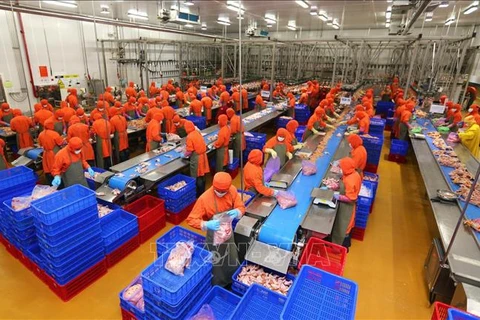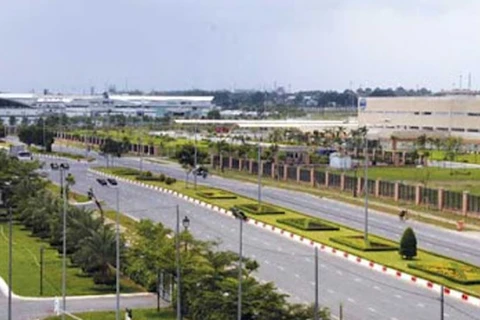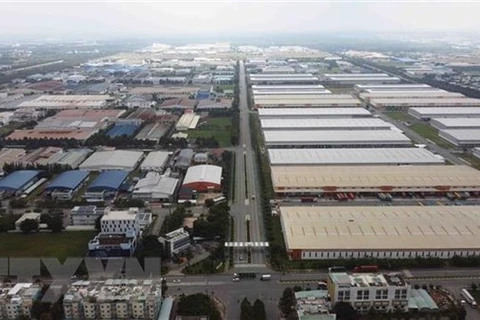Hanoi (VNS/VNA) - Real estate enterprises should actively find alternative funding sources such as foreign direct investment (FDI) capital flow to curb their capital shortage as popular capital mobilisation channels for the realty industry have been tightened.
Capital mobilisation, especially for the real estate industry, is forecast to get tougher as interest rates in both the world and Vietnam keep rising.
Under global volatility, major economies such as the US, the UK and Canada have quickly tightened their monetary policy. The US Federal Reserve (Fed) raised interest rate five times this year to 3.75-4%, the highest rate since January 2008. More rate hikes are forecast in the last months of 2022 and 2023, which will increase pressure on interest and exchange rates, and inflation in Vietnam.
In Vietnam, the State Bank of Vietnam (SBV) had to increase policy interest rates twice in a month by a total of 200 basis points. Accordingly, the refinancing rate is 6% per year, up from 5%, while the rediscount rate is 4.5% per year, up from 3.5%.
Currently, bank credit is limited as the General Statistics Office reported credit by the end of October this year surged by 11.5%. Therefore, if the SBV keeps its credit growth target in 2022 at 14% as planned previously, credit will be allowed to expand by only 2.5% in the last two months of this year.
Experts said it is difficult for the SBV to extend the credit growth target to more than 14% this year, especially when inflation is posing higher risks with the consumer price index (CPI) in October recorded at 4.3%.
With the 2.5% credit growth quota in the last two months of 2022, banks therefore will prioritise financing only production and business, excluding real estate.
At a meeting of the National Assembly on November 3, SBV’s Governor Nguyen Thi Hong said real estate loans were being restricted to protect commercial banks and control inflation.
At a time when inflation control and bank safety are put first, it would be unwise to increase lending to real estate businesses, she noted, adding the central bank’s monetary policy was to ensure macroeconomic stability and capital safety for commercial banks. Meanwhile, it would be potentially risky to lend to real estate businesses because real estate loans were huge and would come with a long term.
Hong said bank credit was just one of the funding sources for the property market and property businesses could raise capital from other sources.
Neil MacGregor, Managing Director of Savills Vietnam, said the Government and the SBV were making strong efforts to control inflation and stabilise the macro-economic environment, which would help the country’s economy grow healthily and sustainably in the medium- and long-term, news portal dangcongsan.vn reported.
He said the Government's initiative in tightening capital mobilisation channels, such as corporate bonds and bank credit, would have certain short-term adverse impacts on many industries, including real estate. In return, Vietnam would have a more transparent financial market and gain increasing credibility in the eyes of international investors. However, the move had limited the domestic capital access of real estate enterprises. Investors and developers in the real estate industry, therefore, were being pushed into a challenging period when capital mobilisation channels, such as bond issuance, bank credit and the stock market, were disrupted.
According to a report from the Ministry of Finance, the bond issuance value of real estate enterprises in the first three quarters of 2022 decreased sharply to about 93 trillion VND, accounting for 28.87% of the country’s total bond issuance value.
FDI capital flow
To ensure the real estate industry maintains a stable recovery rate and meets the needs of other economic sectors, MacGregor suggested real domestic estate enterprises raise capital from the foreign direct investment (FDI) flow.
While the capital mobilisation channels, including corporate bonds and bank credit, were not feasible, real estate enterprises should look to FDI capital as a suitable solution, he said, noting after more than 30 years of implementing the open-door policy to attract FDI, Vietnam had so far received investment from 140 countries and territories around the world. Manufacturing and real estate had been the most attractive industries to foreign investors. It must be affirmed that FDI capital was one of the most important sources for Vietnam.
Finding capital for the real estate industry from FDI flows was entirely possible because the interest of foreign investors in the Vietnamese market today was very big, MacGregor said.
According to the Ministry of Planning and Investment’s Foreign Investment Agency, as of October 20, the total registered FDI capital to Vietnam reached 22.46 billion USD, down 5.4% over the same period in 2021. However, the foreign flows to real estate continued to surge in the period, helping the industry rank second in the list of industries attracting FDI with more than 3.87 billion USD, against 2.12 billion USD in the same period last year.
MacGregor believed with existing cleared land resources as well as transparent working methods and available competence, it would not be difficult for domestic real estate enterprises to find suitable foreign investors.
With the advantages of understanding the domestic market and administrative procedures, many Vietnamese real estate enterprises had so far cooperated with foreign investors, who have good experience and financial strength, to supply the market with many large-sized real estate projects in every segment with good quality, he said./.
Capital mobilisation, especially for the real estate industry, is forecast to get tougher as interest rates in both the world and Vietnam keep rising.
Under global volatility, major economies such as the US, the UK and Canada have quickly tightened their monetary policy. The US Federal Reserve (Fed) raised interest rate five times this year to 3.75-4%, the highest rate since January 2008. More rate hikes are forecast in the last months of 2022 and 2023, which will increase pressure on interest and exchange rates, and inflation in Vietnam.
In Vietnam, the State Bank of Vietnam (SBV) had to increase policy interest rates twice in a month by a total of 200 basis points. Accordingly, the refinancing rate is 6% per year, up from 5%, while the rediscount rate is 4.5% per year, up from 3.5%.
Currently, bank credit is limited as the General Statistics Office reported credit by the end of October this year surged by 11.5%. Therefore, if the SBV keeps its credit growth target in 2022 at 14% as planned previously, credit will be allowed to expand by only 2.5% in the last two months of this year.
Experts said it is difficult for the SBV to extend the credit growth target to more than 14% this year, especially when inflation is posing higher risks with the consumer price index (CPI) in October recorded at 4.3%.
With the 2.5% credit growth quota in the last two months of 2022, banks therefore will prioritise financing only production and business, excluding real estate.
At a meeting of the National Assembly on November 3, SBV’s Governor Nguyen Thi Hong said real estate loans were being restricted to protect commercial banks and control inflation.
At a time when inflation control and bank safety are put first, it would be unwise to increase lending to real estate businesses, she noted, adding the central bank’s monetary policy was to ensure macroeconomic stability and capital safety for commercial banks. Meanwhile, it would be potentially risky to lend to real estate businesses because real estate loans were huge and would come with a long term.
Hong said bank credit was just one of the funding sources for the property market and property businesses could raise capital from other sources.
Neil MacGregor, Managing Director of Savills Vietnam, said the Government and the SBV were making strong efforts to control inflation and stabilise the macro-economic environment, which would help the country’s economy grow healthily and sustainably in the medium- and long-term, news portal dangcongsan.vn reported.
He said the Government's initiative in tightening capital mobilisation channels, such as corporate bonds and bank credit, would have certain short-term adverse impacts on many industries, including real estate. In return, Vietnam would have a more transparent financial market and gain increasing credibility in the eyes of international investors. However, the move had limited the domestic capital access of real estate enterprises. Investors and developers in the real estate industry, therefore, were being pushed into a challenging period when capital mobilisation channels, such as bond issuance, bank credit and the stock market, were disrupted.
According to a report from the Ministry of Finance, the bond issuance value of real estate enterprises in the first three quarters of 2022 decreased sharply to about 93 trillion VND, accounting for 28.87% of the country’s total bond issuance value.
FDI capital flow
To ensure the real estate industry maintains a stable recovery rate and meets the needs of other economic sectors, MacGregor suggested real domestic estate enterprises raise capital from the foreign direct investment (FDI) flow.
While the capital mobilisation channels, including corporate bonds and bank credit, were not feasible, real estate enterprises should look to FDI capital as a suitable solution, he said, noting after more than 30 years of implementing the open-door policy to attract FDI, Vietnam had so far received investment from 140 countries and territories around the world. Manufacturing and real estate had been the most attractive industries to foreign investors. It must be affirmed that FDI capital was one of the most important sources for Vietnam.
Finding capital for the real estate industry from FDI flows was entirely possible because the interest of foreign investors in the Vietnamese market today was very big, MacGregor said.
According to the Ministry of Planning and Investment’s Foreign Investment Agency, as of October 20, the total registered FDI capital to Vietnam reached 22.46 billion USD, down 5.4% over the same period in 2021. However, the foreign flows to real estate continued to surge in the period, helping the industry rank second in the list of industries attracting FDI with more than 3.87 billion USD, against 2.12 billion USD in the same period last year.
MacGregor believed with existing cleared land resources as well as transparent working methods and available competence, it would not be difficult for domestic real estate enterprises to find suitable foreign investors.
With the advantages of understanding the domestic market and administrative procedures, many Vietnamese real estate enterprises had so far cooperated with foreign investors, who have good experience and financial strength, to supply the market with many large-sized real estate projects in every segment with good quality, he said./.
VNA
























